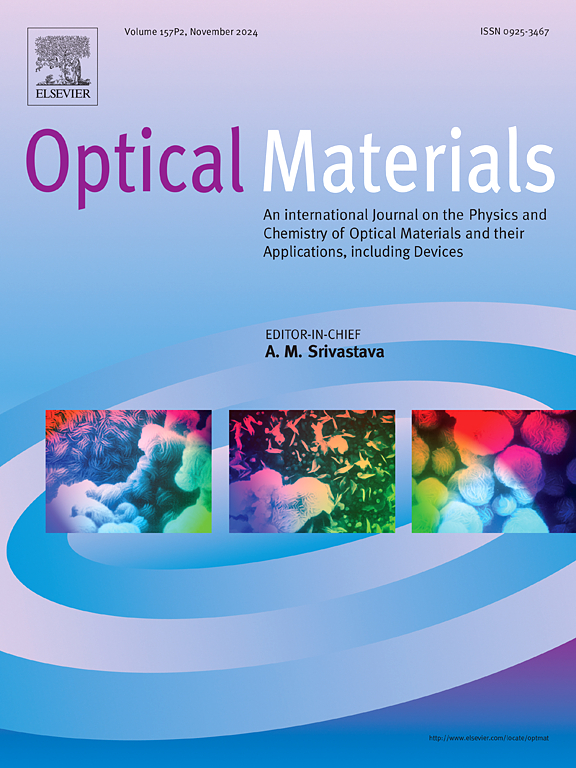硅烷改性层状双氢氧化物与铕传感器,用于水体单线态氧检测
IF 3.8
3区 材料科学
Q2 MATERIALS SCIENCE, MULTIDISCIPLINARY
引用次数: 0
摘要
本文介绍了一种硅烷改性的层状双氢氧化物(LDH)混合物,该混合物具有共价耦合的铕络合物,可用于水体单线态氧(1O2)的检测。Mg/AL-LDH 同时使用两种烷氧基硅烷进行改性,以增加其共价连接性(使用 -SH 或 -NH2 基团)并改善其在水中的分散性(使用 -N+(CH3)3 基团)。1O2 反应性铕复合物通过环氧菲罗啉(5,6-Epoxy-5,6-dihydro- [1,10]phenanthroline,"ephen")与 -SH 或 -NH2 改性 LDH 相耦合,环氧菲罗啉一方面通过其杂芳香族 N 原子作为铕的辅助配体,另一方面允许其环氧基团与改性 LDH 共价连接。通过这种方式,硅烷链使铕复合物远离具有化学活性的 LDH 表面,从而保持了其结构的完整性和光物理特性。因此,这种可在水中分散的探针对 1O2 有显著的反应。这表现在 613 纳米波长的 Eu3+ 发射特征显著增加,在暴露于 1O2 时,发射强度增加了 27 倍,衰减时间为 380 μs。由此产生的 Eu-LDH 混合物适用于异质水 1O2 检测;其衰减时间长,可用于时间门控测量,再加上 LDH 的生物相容性,使其特别适用于需要监测 1O2 的生物基质。本文章由计算机程序翻译,如有差异,请以英文原文为准。
Silane-modified layered double hydroxides with europium sensor for aqueous singlet oxygen detection
A silane-modified layered double hydroxide (LDH) hybrid with a covalently coupled europium complex for aqueous singlet oxygen (1O2) detection is presented. A Mg/AL-LDH is modified with two alkoxysilanes simultaneously to increase its covalent linkability (using –SH or –NH2 groups) and to improve its dispersibility in water (using –N+(CH3)3 groups). The 1O2-responsive europium complex is coupled to the –SH or –NH2 - modified LDH employing epoxyphenanthroline (5,6-Epoxy-5,6-dihydro- [1,10]phenanthroline, “ephen”), which is acting as an ancillary ligand to the europium via its hetero-aromatic N-atoms on one hand and allows the covalent linkage of its epoxy-group to the modified LDH on the other hand. In this manner, the silane chains keep the europium complex away from the chemically active LDH surface, hence maintaining its structural integrity and photophysical properties. The result is a water-dispersible probe with a remarkable response to 1O2. This is signaled by the significant increase in the characteristic Eu3+ emission at 613 nm resulting in up to a 27-fold increase in emission intensity on exposure to 1O2 having a decay time of 380 μs. The resulting Eu-LDH hybrid is applicable for heterogeneous aqueous 1O2 detection; its long decay time, useful in time-gated measurements, in conjunction with the biocompatibility of LDH makes it particularly suitable for biological matrices, where 1O2 needs to be monitored.
求助全文
通过发布文献求助,成功后即可免费获取论文全文。
去求助
来源期刊

Optical Materials
工程技术-材料科学:综合
CiteScore
6.60
自引率
12.80%
发文量
1265
审稿时长
38 days
期刊介绍:
Optical Materials has an open access mirror journal Optical Materials: X, sharing the same aims and scope, editorial team, submission system and rigorous peer review.
The purpose of Optical Materials is to provide a means of communication and technology transfer between researchers who are interested in materials for potential device applications. The journal publishes original papers and review articles on the design, synthesis, characterisation and applications of optical materials.
OPTICAL MATERIALS focuses on:
• Optical Properties of Material Systems;
• The Materials Aspects of Optical Phenomena;
• The Materials Aspects of Devices and Applications.
Authors can submit separate research elements describing their data to Data in Brief and methods to Methods X.
 求助内容:
求助内容: 应助结果提醒方式:
应助结果提醒方式:


